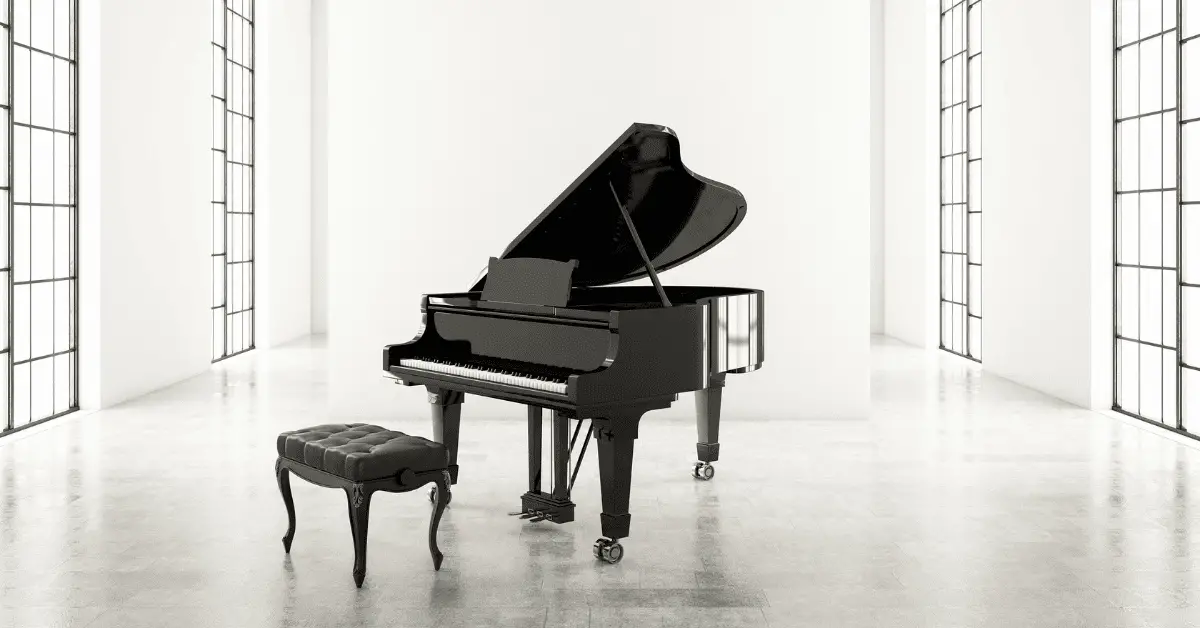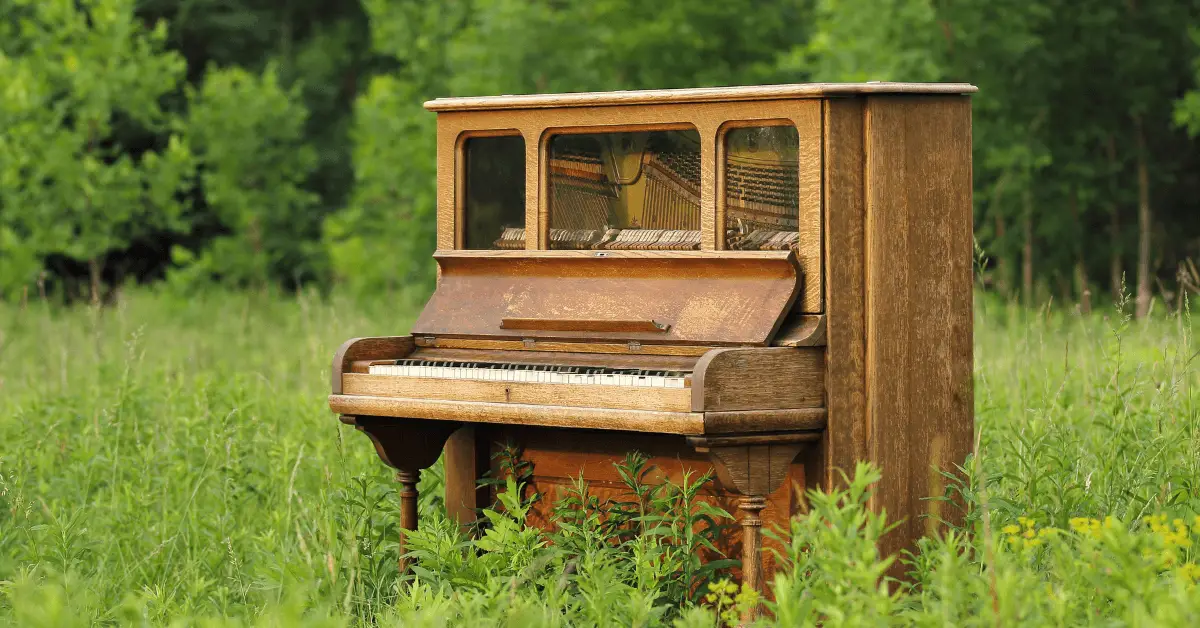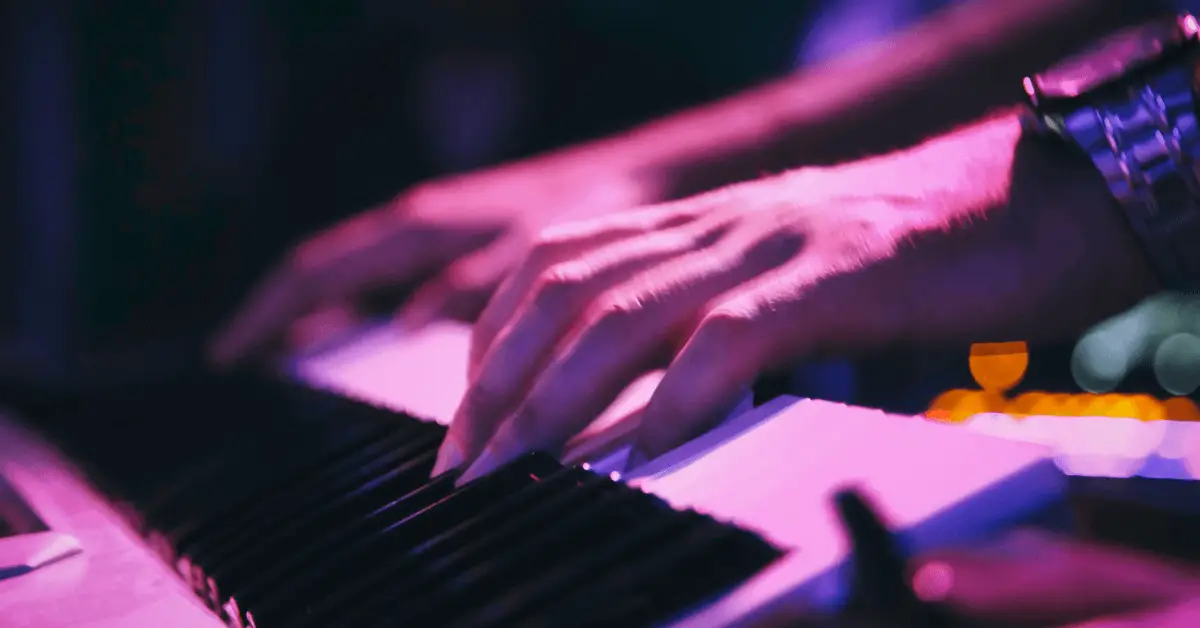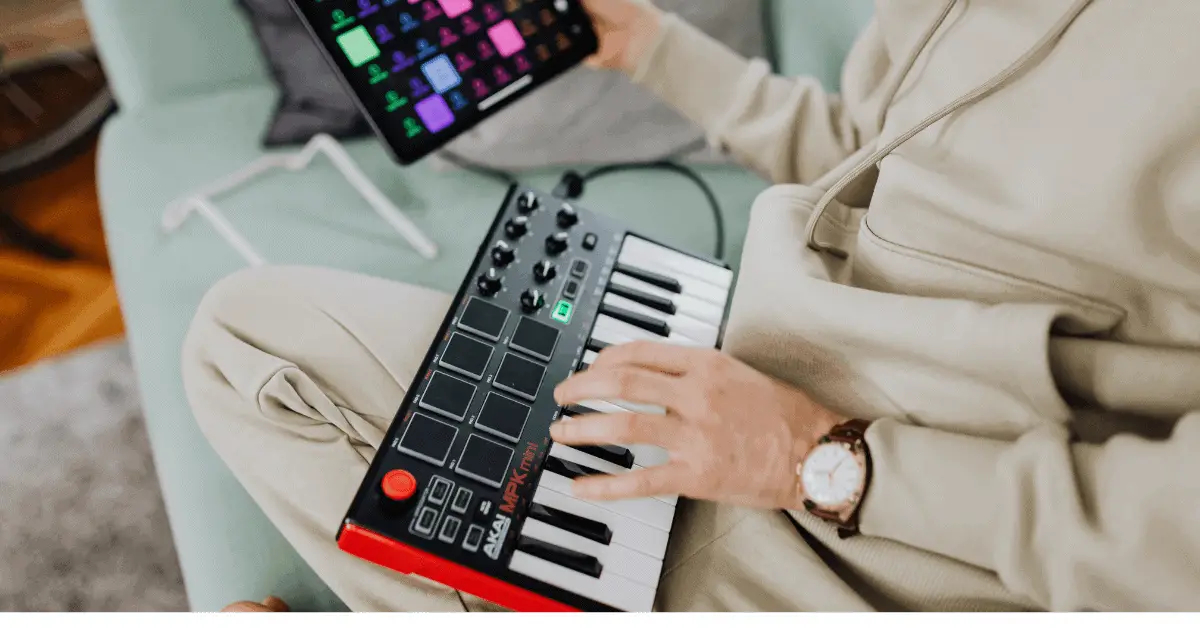Discover the 5 main categories and 13 subcategories of pianos, from traditional grands to modern digitals. Choose the perfect piano for your needs today!
Pianos come in different shapes and sizes, and each has its own unique sound and character. As a beginner, it can be overwhelming to choose the right instrument for your needs.
In this article, we will delve into the five main types of pianos and their 13 subtypes, to help you make an informed decision. From grand pianos to uprights, spinets to consoles, we explain the differences between each type and what makes them stand out.
Whether you are a novice or a seasoned player, understanding the different types of pianos can help you find the one that suits your skill level, budget, and preferences. Let’s dive deep into each main and subtype:
Grand Piano

A grand piano is a majestic, time-honored musical instrument that is widely cherished for its grandiose design, rich tonal qualities, and dynamic expressiveness. It typically consists of a large horizontally-oriented soundboard encased within a decorative wooden frame, with strings and a metal harp strung across its length.
The grand piano distinguishes itself from its smaller and more common counterpart, the upright piano, by its sheer size and the positioning of its strings which allows for greater resonance and superior acoustics. Furthermore, grand pianos come in various sizes, with the most prominent being the concert grand, parlor grand, and baby grand.
These classifications are based on the length of the instrument, which directly impacts the richness of the sound and the overall playing experience. The sophisticated mechanism of the grand piano, involving hammers striking the strings upon pressing the keys, renders delicate nuances and expressive touch, making it a staple in concert halls and professional settings.
Despite its hefty price tag and space requirements, the grand piano remains an extraordinary symbol of musical heritage, offering incomparable depth, warmth, and aural beauty that continues to enthrall generations of musicians and listeners alike.
Petite Grand Piano
A Petite Grand Piano, as the name suggests, is a smaller version of a traditional grand piano, designed to suit the needs of individuals with limited space, whilst still retaining the elegance and charm associated with the grand piano. Ranging between 53 to 58 inches in length, this compact instrument provides a perfect balance between sound quality and space efficiency, making it a popular choice among those who desire the grand aesthetic in a more manageable size.
Despite its smaller size, the Petite Grand Piano still offers a rich and resonant sound, achieved through meticulous craftsmanship and the strategic placement of strings and hammers within the curved body of the piano. It serves as a testament to the beauty of creative innovations, blending timeless elegance with modern sensibilities, thereby allowing more people to experience the joy of owning and playing a grand piano within the confines of their own living spaces.
Size: 4 feet 5 inch – 4 feet 10 inch
Learning Difficulty: For Beginners
Pros:
- Clean, but with lesser sound due to a smaller soundboard and body case
- The economy of space
Baby Grand Piano
A baby grand piano is a smaller and more compact version of the classic grand piano, designed to provide a more space-friendly option for those who desire the elegance and superior sound quality of a grand piano but may have limitations in room size or budget.
Typically ranging in size from approximately 59 to 72 inches in length, the baby grand piano combines the intricacies of the grand piano’s sound and design with a more practical form.
Its strings and soundboard are slightly shorter than those of a full-size grand piano, yet it still boasts a powerful and rich tone, allowing both performance and practice of various music genres. Ideal for smaller performance venues or home use, the baby grand piano is an exquisite blend of functionality, aesthetic appeal, and musical excellence, making it a popular choice for many pianists and music enthusiasts alike.
Size: 4 feet 11 inches – 6 feet
Learning difficulty: For Beginners
Pros:
- High-quality sound output
Medium Grand Piano
A medium grand piano is a type of grand piano that serves as a perfect balance between the majestic and powerful sound produced by concert grand pianos and the more compact design and affordability of baby grand pianos.
Typically, medium grand pianos range in size from 68 inches, which allows for more complete harmonic bass response and dynamic tonal clarity than their smaller counterparts. These instruments are crafted with the same attention to detail, fine materials, and skilled craftsmanship as concert grand pianos, but their modest size makes them more suitable for home use or smaller venues where space is at a premium.
Despite their size, medium grand pianos offer impressive acoustics that can complement various performance styles and genres. Their versatility, combined with their rich tonal quality and manageable size, make medium grand pianos an ideal choice for passionate and discerning pianists.
Size: 5 feet 8 inches
Learning difficulty: For Professionals
Pros:
- Quality sound output
Professional Grand Piano
A professional grand piano is a high-quality, precision-crafted musical instrument that epitomizes the pinnacle of excellence in both design and performance. Often the preferred choice of skilled pianists, composers, and prestigious music venues, these majestic instruments boast immense power, rich tonal variation, and exceptional sound quality.
Typically much larger in comparison to their smaller counterparts, such as baby grands, professional grand pianos range from approximately six to nine feet in length, resulting in a deeper and more resonant sound. Renowned for their unparalleled craftsmanship, leading manufacturers like Steinway & Sons, Bösendorfer, and Yamaha meticulously create their instruments using superior materials, state-of-the-art technology, and the expertise of master piano makers.
Acquiring a professional grand piano not only signifies an investment in the auditory and aesthetic enhancement of any space it inhabits, but it also serves as a testament to the profound appreciation and dedication one has toward the art of music.
Parlor Grand Piano
A parlor grand piano, also known as a “baby grand” / “medium grand” / “living room grand”, is a type of smaller concert grand piano that offers the perfect balance between size and sound quality. These exquisite instruments typically measure from 70 inches to 84 inches in length, making them an ideal choice for smaller performance spaces or private homes.
Despite their diminutive size, parlor grand pianos are revered for their rich, resonant tone that is comparable to their larger counterparts, the concert grand pianos. Their carefully designed soundboard and strings provide impressive volume and clarity in a more compact frame.
Often favored by professional musicians and aficionados alike, the parlor grand piano stands as an artistic masterpiece, merging exceptional craftsmanship with an elegant aesthetic. Its combination of versatility and unparalleled sound quality has secured the parlor grand piano’s lasting popularity and prestige within the world of music.
Size: ~6 feet – 7 feet
Learning difficulty: For Beginners and Intermediates
Pros:
- Benefits of the concert grand in a small package
Semi-Concert Grand Piano
A Semi-Concert Grand or Ballroom Grand Piano is an exceptional class of grand piano that offers a perfect balance between size and sound quality. Typically, these instruments range from approximately 74 to 79 inches in length, making them smaller than a full concert grand but larger than a standard grand.
This unique size offers enhanced tonal power, depth, and projection, making it an ideal choice for mid-sized performance spaces, such as ballrooms, recital halls, or intimate concert venues.
The Semi-Concert Grand Piano is known to provide a rich, vibrant sound and exceptional responsiveness to the player’s touch, making it highly sought-after by professional pianists and musicians.
Revered by manufacturers and aficionados alike, the Ballroom Grand Piano is often considered the epitome of acoustic piano craftsmanship, representing a harmonious blend of aesthetic beauty, delicate touch, and expressive, sonorous sound.
Size: 6 feet 2 inch – 6 feet 7 inch
Learning difficulty: for beginners and intermediates
Pros:
- Quality sound
- Quality strings
Concert Grand Piano
A Concert Grand Piano is the epitome of musical excellence and craftsmanship in the world of pianos. These masterpieces are the largest and most impressive of all grand pianos, usually measuring between 7 and 10 feet in length. Designed for exceptional performance and tonal depth, they are the preferred instrument for world-class concert pianists and prestigious venues.
A Concert Grand Piano, crafted from the finest materials and employing intricate engineering techniques, delivers unparalleled sound and responsiveness. Its increased soundboard area and string length result in a richer and more resonant sound, capable of filling even the largest concert halls with its majestic presence.
Having a Concert Grand Piano on stage is often seen as a statement of dedication to the highest standards of artistic expression and musicality, making it a highly regarded symbol of excellence in the world of music.
Size: ~7 feet – 9 feet
Learning difficulty: For Professionals
Pros:
- cleanest and most quality sound
- Quality materials used in its construction
Upright Piano

An upright piano, also known as a vertical piano, is a type of acoustic piano characterized by its compact and vertical structure, as opposed to the horizontal design of grand pianos. The primary distinction of an upright piano lies in its unique soundboard and string orientation.
Rather than extending horizontally like, in grand pianos, the strings and soundboard in an upright piano are positioned vertically, allowing the instrument to occupy a smaller footprint and making it more suitable for spaces with limited room.
Despite its compact design, the upright piano still produces rich and dynamic sounds, primarily due to its well-engineered action mechanism, which transfers the energy from the pianist’s fingers to the hammers within the instrument to strike the strings.
Upright pianos are available in various sizes, including spinet, console, studio, and full-size upright models, each offering different levels of sound quality, touch responsiveness, and overall performance. Generally, larger upright pianos provide a more resonant and richer sound due to their longer strings and larger soundboard, thereby offering a more satisfying playing experience for pianists.
Upright pianos are popular among musicians, students, and enthusiasts due to their cost-effectiveness and adaptability to various settings, such as homes, schools, and smaller performance venues.
Overall, the upright piano brings together the elements of visual elegance, space efficiency, and aural beauty in a single instrument, making it a highly desirable choice for many musicians and music aficionados.
Spinet Piano
A spinet piano is a compact, upright piano that features a unique, space-saving design, originating from the early 20th century. A smaller version of the traditional piano, the spinet measures between 36 to 40 inches in height, making it an ideal choice for individuals with limited space in their homes or studios.
One of the most distinctive characteristics of a spinet piano is its “drop action” mechanism, which places the action below the level of the keyboard, allowing for its reduced size while maintaining a similar tonal quality. However, this configuration can result in a slightly compromised sound, as the shorter strings and soundboard tend to produce a less resonant tone than that of larger pianos.
Despite this, the spinet piano remains a popular choice, particularly for beginners and casual players, due to its affordability, ease of transport, and suitability for smaller spaces.
Console Piano
A console piano is a type of upright piano that is known for its compact design and engaging sound quality. Generally, these pianos are designed to fit in smaller spaces, making them popular choices for homes, schools, and churches. Console pianos typically stand at a height of approximately 40 to 44 inches tall, which is shorter than traditional upright pianos.
Despite this smaller size, console pianos are skillfully crafted with a comprehensive soundboard and reliable action mechanism, ensuring high-quality performance and durability. Console pianos are characterized by their full, rich sound and distinctive aesthetic, often featuring elegant cabinetry and intricate detailing.
They strike a balance between affordability and musical excellence, making them an attractive option for those who wish to invest in a versatile piano suitable for both casual enjoyment and concentrated practice.
Studio Piano
A studio piano, also commonly known as an upright piano, is a space-efficient musical instrument that holds significant appeal for musicians, composers, and piano enthusiasts alike. Designed to fit comfortably within the limited confines of a home, school, or any other setting with spatial constraints, studio pianos provide a resoundingly rich and dynamic sound that closely resembles that of a grand piano.
Comprising a vertically-aligned soundboard and frame, the studio piano optimally utilizes its compact dimensions to deliver a remarkable tonal range, making it the ideal choice for both practice and performance purposes. With its sleek appearance and versatile acoustic properties, a studio piano serves as an excellent instrument for students, teachers, and hobbyists who wish to explore the elegant world of piano music without compromising on quality or requiring excessive space.
Electric/Digital Piano

An electronic or digital piano is a versatile musical instrument designed to emulate the sounds and functionality of a traditional acoustic piano while providing additional features and benefits. It uses digital technology to create high-quality, realistic piano tones through digital sampling or synthesis methods This allows the digital piano to replicate not only the sound but also the playing experience of an acoustic piano, including touch sensitivity and dynamic range.
One of the significant advantages of a digital piano is its compact size and portability, making it a popular choice for those with limited space or those who need to transport their instrument easily. Electronic pianos often come with a wide array of built-in features, such as multiple instrument voices, onboard effects (e.g., reverb, chorus), and diverse connectivity options for amplification and recording.
Moreover, digital pianos often include a MIDI capability, which allows them to be connected to computers or other electronic devices for additional functionality and usage in music composition and mixing. As a result, digital pianos have become a staple in music education, performance, and production due to their ease of use, versatility, and cost-efficiency when compared to their acoustic counterparts.
Specialized Piano
Toy Piano
A toy/specialized piano is a miniature version of a traditional piano, designed specifically for young children, enthusiasts, or collectors. These pint-sized musical instruments are crafted with the purpose of introducing beginners to the world of music, or simply as a unique decorative piece for music lovers.
While they often resemble the appearance of a standard piano in terms of keys and design, their compact size allows for easy portability and accessibility.
Generally, toy or specialized pianos feature 18 to 25 keys, covering a limited range of musical notes, making it ideal for simple music practice and exploration. Despite their diminished size, these pianos are engineered to produce relatively accurate sound quality and enable users to experience the basic principles of playing the piano.
Overall, a toy/specialized piano serves as a delightful and educational tool, providing an endearing and immersive musical experience to all who engage with it.
Size: 1-3 octaves
Learning difficulty: For children
Pros:
- Metal or glass sound rods
- Quarter tones between E/F. B/C
Player Piano
A player piano, also known as a pianola, is a unique type of self-playing piano that originated in the late 19th and early 20th centuries. It is designed with an internal mechanism, typically operated by either air pressure or electromechanical means, which enables the piano to play music automatically without requiring a human pianist.
The instrument uses pre-programmed perforated sheets, known as piano rolls, which contain the encoded musical notation of a specific piece. As these rolls move through the piano’s mechanism, they trigger the corresponding keys, activating the hammers and strings, thus producing the desired notes and melodies.
The advent of the player piano popularized both classical and popular music in homes and other public spaces, greatly expanding access to and enjoyment of live music performances. With advancements in technology, modern-day versions of the player piano often use digital systems and MIDI files for more versatile and sophisticated musical performances.
Size: 48” in height and 58” in width
Learning difficulty: for intermediates and professionals
Pros:
- Entertainment for audiences
- Special music rolls of paper or metal
Silent Piano
A silent piano, as the name suggests, is a unique hybrid musical instrument that combines the best of both the traditional acoustic piano and modern digital technology, offering piano players the ability to practice and play without disturbing others around them.
At its core, a silent piano is a standard acoustic piano, complete with hammers and strings, allowing the musician to enjoy the authentic touch and feel that most pianists crave. What sets it apart is its innovative silent system, which, when activated, disengages the hammers from the strings, and instead, relies on sophisticated optical or magnetic sensors that capture the key movements and translate them into digitally-produced sound.
This sound is then transmitted to headphones, providing the pianist with a private and immersive playing experience, even in the quietest of environments. Silent pianos have gained immense popularity among musicians worldwide, for they offer the perfect solution for those who yearn to play without constraints, be it in apartments, late at night, or in shared spaces.
Learning difficulty: For beginners and intermediates.
Pros:
- Silent practice
- Optical sensors
Hybrid Piano (MIDI Controller)

A hybrid piano, also known as a MIDI controller, is a modern innovation in the world of music technology, effortlessly combining the traditional feel and appearance of an acoustic piano with the advanced functionality and adaptability of a digital piano.
This unique musical instrument allows musicians to enjoy the best of both worlds, providing a truly versatile playing experience. The term “MIDI” stands for “Musical Instrument Digital Interface,” which refers to a technical standard in communication that enables the hybrid piano to connect seamlessly with other electronic devices, such as computers or synthesizers.
One of the most significant features of a hybrid piano is its compatibility with a wide range of digital sounds and instruments, giving musicians the ability to easily switch between various sound options and create complex, layered compositions. This versatility not only expands the musical possibilities but also serves as a valuable tool for composing, recording and performing in different genres and styles.
Additionally, the hybrid piano often includes advanced capabilities such as recording functions, enhanced or customizable touch response, and even educational features, making it an excellent option for both amateur and professional musicians.
In conclusion, hybrid pianos, or MIDI controllers, are forging a new path in the world of music technology by bridging the gap between the authenticity of an acoustic piano and the versatility of a digital one. Musicians can now enjoy limitless creative possibilities while experiencing the familiar touch and artistry of a traditional instrument.
Are the Different Types of Pianos Available for Free Access?
Exploring the world of pianos, many wonder about various options for access. Understanding the concept of free pianos reveals that while digital platforms may offer free trials, most pianos require investment. From upright to grand, the diversity remains, but true quality often comes with a price tag.
FAQ
What Are The Main Piano Types?
There are 5 types of main pianos that include Grand Piano, Upright Piano, Digital Piano, Hybrid Piano, and Specialized Piano. The Grand piano includes Petite Grand Piano, Baby Grand Piano, Medium Grand Piano, Professional Grand Piano, Parlor Grand Piano, Semi-Concert Grand Piano, and Concert Grand Piano. The Upright Piano includes Spinet, Console, and Studio Piano. And Specialized Piano includes Toy Piano, Player Piano, and Silent Piano.
Do I choose a digital piano or an acoustic piano?
Choosing between an acoustic piano and a digital piano can be a difficult decision. While an acoustic piano offers the authentic and rich sound of hammers striking strings, a digital piano provides the versatility of various sounds and the convenience of being able to play with headphones. It ultimately comes down to personal preference and the intended use of the instrument. An acoustic piano is suitable for classical or traditional music while a digital piano may be better for contemporary and modern styles.
What are the benefits of a digital piano?
A digital piano has numerous benefits over an acoustic piano. Firstly, it allows the user to play the piano in a more versatile way, often featuring 10 types of pianos in one keyboard. Secondly, it is smaller and lighter than an acoustic piano, making it easier to transport and store. Lastly, the sound of a digital piano can be amplified, making it suitable for live performances. In short, digital pianos are a perfect type of piano for those who want to play the piano without the physical or financial investment of an electric piano.
Final Verdict
In conclusion, understanding the different types of pianos is key to selecting an instrument that will suit your needs and preferences. The five main categories – grand, upright, digital, hybrid, and specialized pianos – each offer unique features and benefits for different playing styles and environments.
Furthermore, within each of these main categories are smaller subcategories that offer even more specialized features. From the bright sound of a baby grand piano to the versatility of a digital stage piano with multiple sounds and effects, there are numerous options available.
Ultimately, it’s important to consider your budget as well as your musical goals when selecting a piano. Whether you’re a professional musician or just starting out with lessons, knowing which type of piano will best support your learning and playing style can help you achieve success in your musical endeavors.
